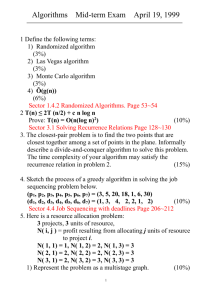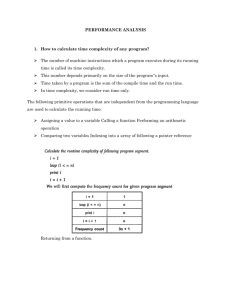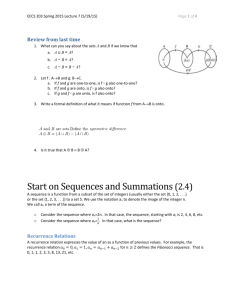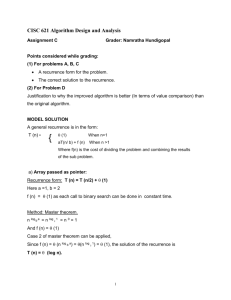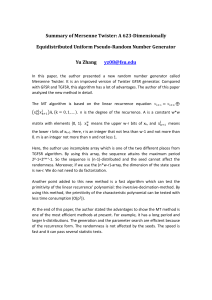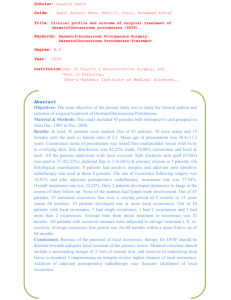April 11 - Berkeley
advertisement
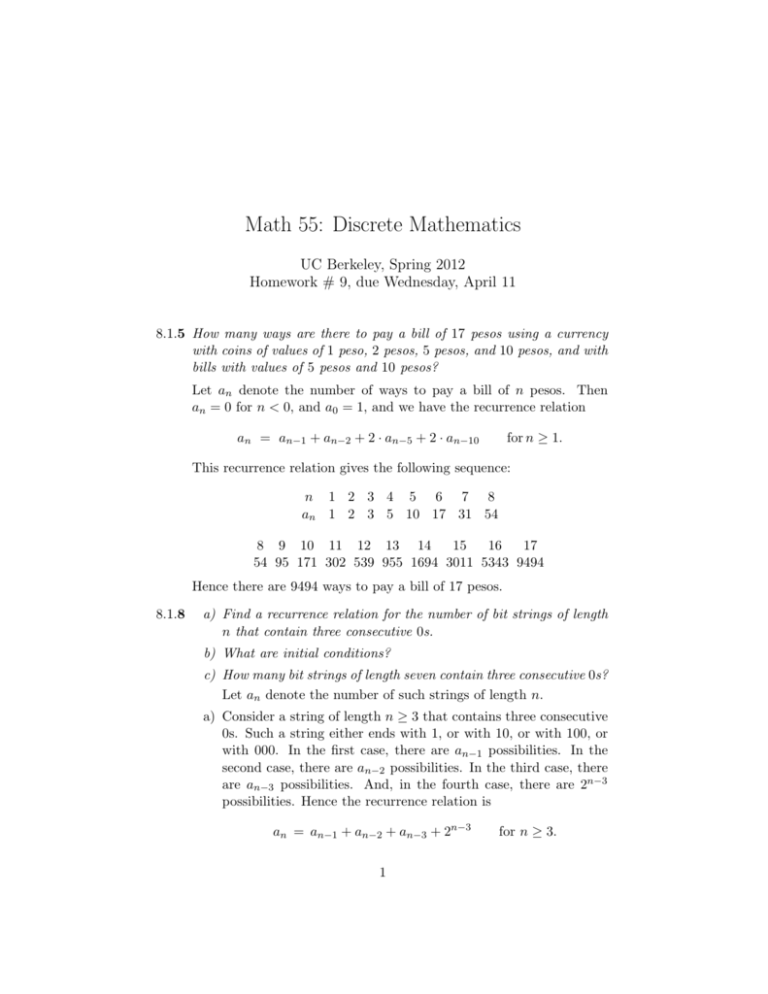
Math 55: Discrete Mathematics
UC Berkeley, Spring 2012
Homework # 9, due Wednesday, April 11
8.1.5 How many ways are there to pay a bill of 17 pesos using a currency
with coins of values of 1 peso, 2 pesos, 5 pesos, and 10 pesos, and with
bills with values of 5 pesos and 10 pesos?
Let an denote the number of ways to pay a bill of n pesos. Then
an = 0 for n < 0, and a0 = 1, and we have the recurrence relation
an = an−1 + an−2 + 2 · an−5 + 2 · an−10
for n ≥ 1.
This recurrence relation gives the following sequence:
n 1 2 3 4 5 6 7 8
an 1 2 3 5 10 17 31 54
8 9 10 11 12 13 14
15
16
17
54 95 171 302 539 955 1694 3011 5343 9494
Hence there are 9494 ways to pay a bill of 17 pesos.
8.1.8
a) Find a recurrence relation for the number of bit strings of length
n that contain three consecutive 0s.
b) What are initial conditions?
c) How many bit strings of length seven contain three consecutive 0s?
Let an denote the number of such strings of length n.
a) Consider a string of length n ≥ 3 that contains three consecutive
0s. Such a string either ends with 1, or with 10, or with 100, or
with 000. In the first case, there are an−1 possibilities. In the
second case, there are an−2 possibilities. In the third case, there
are an−3 possibilities. And, in the fourth case, there are 2n−3
possibilities. Hence the recurrence relation is
an = an−1 + an−2 + an−3 + 2n−3
1
for n ≥ 3.
b) The initial conditions are a0 = a1 = a2 = 0. Note that a3 = 1.
c) The recurrence gives the sequence of positive integers
0, 0, 0, 1, 3, 8, 20, 47, 107, 238, 520, 1121, 2391, . . . .
Hence there are a7 = 47 bit strings of length seven that contain
three consecutive 0s.
8.1.12
a) Find a recurrence relation for the number of ways to climb n
stairs if the person climbing the stairs can take one stair or two
stairs at a time.
b) What are the initial conditions?
c) In how many ways can this person climb a flight of eight stairs?
Let Sn denote the number of ways of climbing the stairs.
a) Let n ≥ 3. The last step either was a single step, for which there
are Sn−1 possibilities, or a double step, for which there are Sn−2
possibilities. The recurrence is Sn = Sn−1 + Sn−2 for n ≥ 3.
b) We have S1 = 1 and S2 = 2. You can take two stairs either
directly or by taking stair at a time.
c) The recurrence gives the Fibonacci sequence
1, 2, 3, 5, 8, 13, 21, 34, 55, . . . .
Hence there are S8 = 34 ways to climb a flight of eight stairs.
8.1.20 A bus driver pays all tolls, using only nickels and dimes, by throwing
one coin at a time into the mechanical toll collector.
a) Find the recurrence relation for the number of different ways the
bus driver can pay a toll of n cents (where the order in which the
coins are used matters).
b) In how many ways can the driver pay a toll of 45 cents?
Let cn denote the number of ways of paying n cents.
a) Consider the coin that was paid last. That coin either is a nickel,
for which there are cn−5 possibilities, or it is a dime, for which
there are cn−10 possibilities. Hence the recurrence relation is
cn = cn−5 + cn−10 for n ≥ 11. Also, the initial conditions are
c1 = c2 = c3 = c4 = c6 = c7 = c8 = c9 = 0, c5 = 1, and c10 = 2.
2
b) This recurrence generates the interspersed Fibonacci sequence
0, 0, 0, 0, 1, 0, 0, 0, 0, 2, 0, 0, 0, 0, 3, 0, 0, 0, 0, 5, 0, 0, 0, 0, 8,
0, 0, 0, 0, 13, 0, 0, 0, 0, 21, 0, 0, 0, 0, 34, 0, 0, 0, 0, 55, . . .
Hence there are c45 = 55 ways for the bus driver to pay toll.
8.1.30
a) Write out all the ways the product x0 · x1 · x2 · x3 · x4 can be
parenthesized to determine the order of multiplication.
b) Use the recurrence relation developed in Example 5 to calculate
Cn , the number of ways to parenthesize the product of five numbers. Verify that you listed the correct number of ways in part (a).
c) Check your result in part (b) by finding C4 , using the closed formula for Cn in the solution of Example 5.
a) There are 14 ways to parenthesize a product of five factors:
(((x0 · x1 ) · x2 ) · x3 ) · x4 , ((x0 · (x1 · x2 )) · x3 ) · x4 ,
((x0 · x1 ) · (x2 · x3 )) · x4 , (x0 · ((x1 · x2 ) · x3 )) · x4 ,
(x0 · (x1 · (x2 · x3 ))) · x4 , (x0 · x1 · x2 ) · (x3 · x4 ) ,
(x0 · x1 · x2 ) · (x3 · x4 ) , (x0 · x1 ) · ((x2 · x3 ) · x4 ) ,
(x0 · x1 ) · (x2 · (x3 · x4 )) , x0 · (((x1 · x2 ) · x3 ) · x4 ) ,
x0 · ((x1 · (x2 · x3 )) · x4 ) , x0 · ((x1 · x2 ) · (x3 · x4 )) ,
x0 · (x1 · ((x2 · x3 ) · x4 )) , x0 · (x1 · (x2 · (x3 · x4 ))).
b) From the recurrence on page 507 we get
C4 = C0 ·C3 +C1 ·C2 +C2 ·C1 +C3 ·C0 = 1·5+1·2+2·1+5·1 = 14.
c) The closed formula for the Catalan numbers is Cn = 2n
/(n+1).
n
8
Substituting n = 4, we confirm C4 − 4 /5 = 70/5 = 14.
8.2.2 Determine which of these are linear homogeneous recurrence relations
with constant coefficients. Also, find the degree of those that are.
a) an = 3an−2
b) an = 3
c) an = a2n−1
d) an = an−1 + an−3
e) an = an−1 /n
3
f ) an = an−1 + an−2 + n + 3
g) an = 4an−2 + 5an−4 + 9an−7
a) This is a linear homogeneous recurrence relation with constant
coefficients of degree 2.
b) This recurrence is not homogeneous.
c) This recurrence is not linear.
d) This is a linear homogeneous recurrence relation with constant
coefficients of degree 3.
e) This recurrence does not have constant coefficients.
f) This recurrence is not homogeneous.
g) This is a linear homogeneous recurrence relation with constant
coefficients of degree 7.
8.2.8 A model for the number of lobsters caught per year is based on the
assumption that the number of lobsters caught in a year is the average
of the number caught in the previous two years.
a) Find a recurrence relation for {Ln } where Ln is the number of
lobsters caught in year n, under the assumption of this model.
b) Find Ln if 100, 000 lobsters were caught in year 1 and 200, 000
lobsters were caught in year 2.
a) Since Ln is the average of Ln−1 and Ln−2 , the recurrence is
1
1
Ln−1 + Ln−2 .
2
2
Ln =
b) The characteristic polynomial x2 − x/2 − 1/2 = 12 (2x + 1)(x − 1)
has the roots 1 and −1/2. Hence there exist real constants c1 and
c2 such that Ln = γ1 + γ2 (−1/2)n . The initial conditions imply
the linear relations γ1 +γ2 = 100000 and γ1 −γ2 /2 = 200000. The
solution is γ1 = 500000/3 and γ2 = −200000/3, and we conclude
cn
=
500000 200000 · (−1/2)n
+
.
3
3
The second term converges to zero. Thus, the steady state scenario is that 166, 667 lobsters will be caught every year.
4
8.2.11 The Lucas numbers satisfy the recurrence relation
Ln = Ln−1 + Ln−2 ,
and the initial conditions L0 = 2 and L1 = 1.
a) Show that Ln = fn−1 + fn+1 for n = 2, 3, . . . , where fn is the nth
Fibonacci number.
b) Find an explicit formula for the Lucas numbers.
a) We define a new sequence {Mn } by setting M0 = 2 and Mn =
fn−1 + fn+1 for n ≥ 1. Then M1 = f0 + f2 = 1 and M2 =
f1 + f3 = 1 + 2 = 3. The two sequences {Mn } and {Ln } satisfy
the same recurrence, and they satisfy the same initial conditions.
Therefore they must be equal.
b) The roots of the characteristic polynomial are given by the golden
ratio, and we find
√ √ 1+ 5 n
1− 5 n
Ln =
+
for n = 0, 1, 2, 3, . . . .
2
2
8.2.18 Solve the recurrence relation an = 6an−1 − 12an−2 + 8an−3 with a0 =
−5, a1 = 4 and a2 = 88.
The characteristic polynomial equals x3 −6x2 +12x−8 = (x−2)3 . We
know from Theorem 4 on page 519 that an = γ1 2n + γ2 n2n + γ3 n2 2n
for some constants γ1 , γ2 , γ3 . By substituting n = 0, 1, 2 into this
equation, we obtain the linear system
γ1 = −5 , 2γ1 + 2γ2 + 2γ3 = 4 and
4γ1 + 8γ2 + 16γ3 = 88.
The solution is γ1 = −5 , c2 = 1/2, c3 = 13/2, and therefore
an
=
−5 · 2n + n · 2n−1 + 13 · n2 · 2n−1
for n = 0, 1, 2, 3, . . . .
8.2.46 Suppose that there are two goats on an island initially. The number
of goats on the island doubles every year by natural reproduction, and
some goats are either added or removed each year.
a) Construct a recurrence relation for number of goats on the island
at the start of the nth year, assuming that during each year an
extra 100 goats are put on the island.
5
b) Solve the recurrence relation from part (a) to find the number of
goats on the island at the start of the nth year.
c) Construct a recurrence relation for number of goats on the island
at the start of the nth year, assuming that n goats are removed
during the nth year for each n ≥ 3.
d) Solve the recurrence relation in part (c) to find the number of
goats on the island at the start of the nth year.
a) Let Gn denote the number of goats on the island at the start of the
nth year. The recurrence is Gn = 2Gn−1 + 100 for n = 1, 2, . . ..
b) A particular solution to his inhomogenous linear recurrence is
100 · (2n − 1). By Theorem 5 on page 521, the solution must have
the form Gn = 100(2n − 1) + γ2n . Since G0 = 2, we see that
γ = 2, and hence the number of goats equals
Gn = 100(2n − 1) + 2n+1
for n = 0, 1, 2, 3, . . . .
c) The recurrence is Gn = 2Gn−1 − n for n = 1, 2, . . .,
d) We observe that the recurrence gives the sequence 2, 3, 4, 5, 6, . . ..
Using mathematical induction, we easily prove that indeed
Gn = n + 2
for n = 0, 1, 2, 3, . . . .
8.4.6** Find a closed form for the generating function for the sequence {an }
where
a) an = −1 for all n = 0, 1, 2, . . .
b) an = 2n for n = 1, 2, 3, 4, . . . and a0 = 0
c) an = n − 1 for n = 0, 1, 2, . . .
d) an = 1/(n + 1)! for 0, 1, 2, . . .
e) an = n2 for n = 0, 1, 2, . . . ,
10
f ) an = n+1
for n = 0, 1, 2, . . .
The following generating functions represent the desired sequences:
a) 1/(x − 1).
b) 2x/(1 − 2x)
6
c) (2x − 1)/(1 − x)2
d) (ex − 1)/x.
e) x2 /(1 − x)3
f) ((x + 1)10 − 1)/x
8.4.8 For each of these generating functions, provide a closed formula for
the sequence it determines.
a) (x2 + 1)3
b) (3x − 1)3
c) 1/(1 − 2x2 )
d) x2 /(1 − x)3
e) x − 1 + (1/(1 − 3x))
f ) (1 + x3 )/(1 + x)3
g) x/(1 + x + x2 )
2
h) e3x − 1
3
n/2
if n is even, and 0 if n is odd
b) −(−3)n n3
a)
c) 2n/2 if n is even, and 0 if n is odd
d) n3
e) 0 for n = 0, 4 for n = 1, and 3n for n ≥ 2.
f) 1 for n = 0, and (−1)n · 3n for n ≥ 1.
g) 0 if n ≡ 0 (mod 3), 1 if n ≡ 1 (mod 3), −1 if n ≡ 2 (mod 3).
h) 2n/2 /(n/2)! if n is even and positive, and 0 otherwise
8.4.14 Use generating functions to determine the number of different ways 12
identical action figures can be given to five children so that each child
receives at most three action figures.
This is the coefficient of x12 in (1 + x + x2 + x3 )5 . It is found to be 35.
So, there are 35 ways of distributing the 12 action figures.
8.4.20 What is the generating function for the sequence {ck }, where ck represents the number of ways to make change for k pesos using bills worth
10 pesos, 20 pesos, 50 pesos and 100 pesos?
7
The generating function for making change with these bills is
∞
X
k=0
xk =
1
(1 −
x10 )(1
−
x20 )(1
− x50 )(1 − x100 )
8.4.22 Give a combinatorial interpretation of the coefficient of x6 in the expansion (1 + x + x2 + x3 + · · · )n . Use this interpretation to find this
number.
This is the number of ways of giving n action figures to six children.
While the action figures are indistinguishable, the children are very
precious and thus we consider them to be distinguishable. More abstractly, that coefficient counts the n-combinations of a set of 6 elements with repetition allowed. The number equals
n+5
.
6
8.4.36 Use generating functions to solve the recurrence relation ak = ak−1 +
2ak−2 + 2k with initial conditions a0 = 4 and a1 = 12.
From the initial conditions and P
the recurrence relation, we find that
k
the generating function G(x) = ∞
k=0 ak x satisfies the identity
G(x) − 4 − 12x = x(G(x) − 4) + 2x2 G(x) +
1
− 1 − 2x.
1 − 2x
We solve this equation for G(x) to find
G(x) =
4 · (1 − 3x2 )
= 4 + 12x + 24x2 + 56x3 + 120x4 + · · ·
(1 − 2x)2 (1 + x)
8


